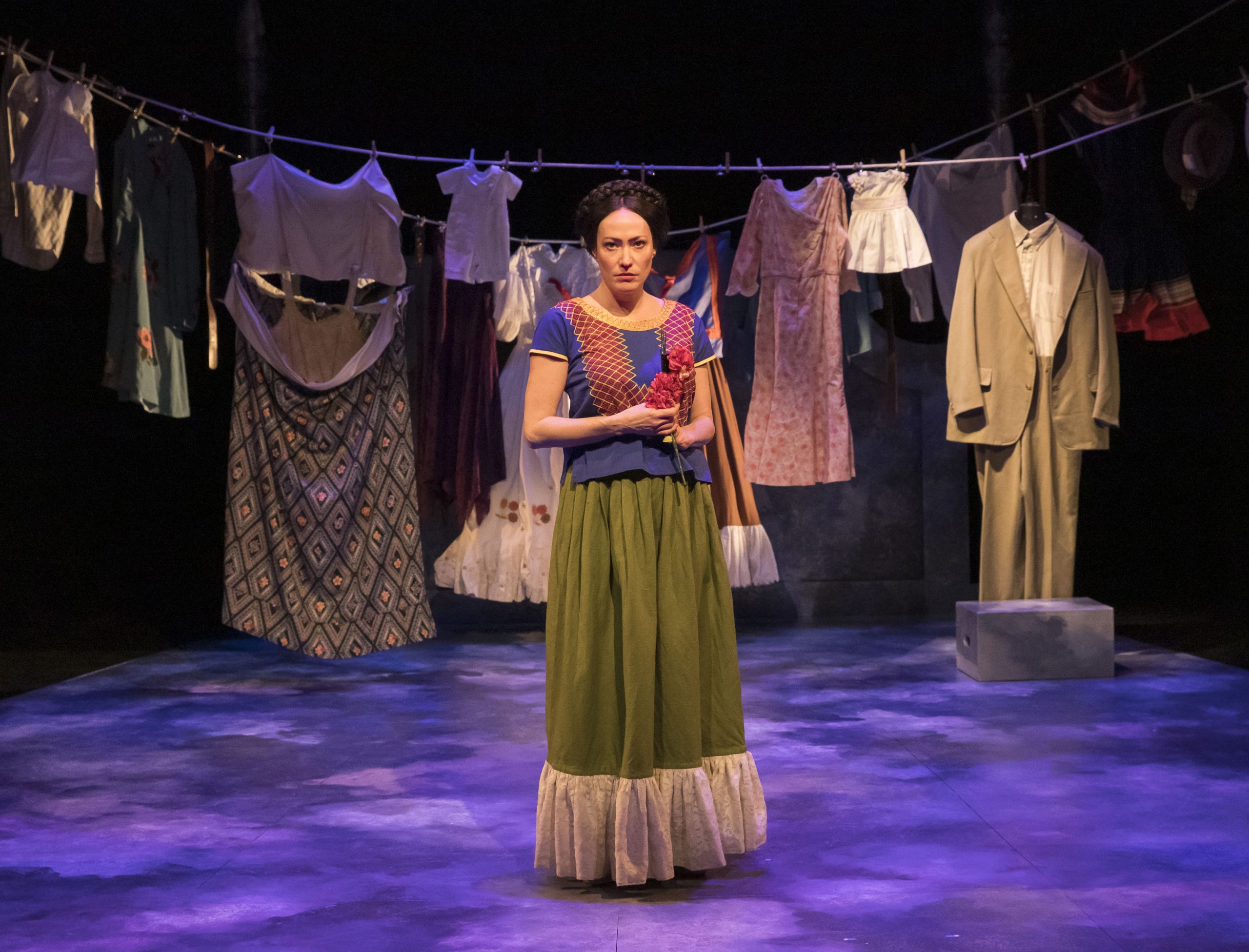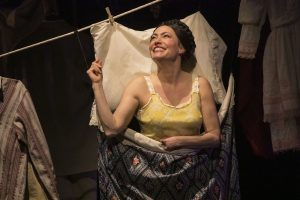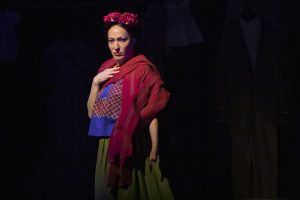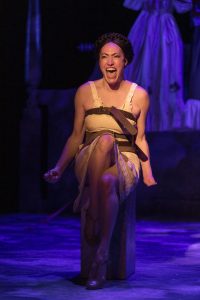
Vanessa Severo – Courtesy of Zach Rosing. Used with permission.
The words channel and inhabit are often used to describe effective performances of actors playing famous figures. In the case of actor-playwriter-choreographer Vanessa Severo, who plays the role of Mexican surrealist painter, Frida Kahlo in “Frida,,,A Self Portrait” at the Indiana Repertory Theatre Upperstage, there are no better descriptions of her portrayal of the revolutionary and pop culture giant who helped to define Mexican identity. Fortunately, I finally had the opportunity, Friday, to view the drama, also written by the gifted Severo who plays the title character.

Vanessa Severo – Courtesy of Zach Rosing. Used with permission.
The play runs one more weekend through Sunday, April 7. If you have yet to experience it, I urge you not to miss it. I especially recommend Severo’s provocative work to those, who like me, are obsessed with the remarkable life of a sexually liberated artist whose work was a commentary on race, gender and class in Mexican society, and which singularly mixed realism with fantasy.
Like other devotees, I am always on the search for added information and insight into Kahlo’s life, so it was with great anticipation, that I was drawn to witness Severo’s depiction. I was not disappointed. If fact, the entire experience was, happily, much, much more than I expected.
Brazilian native Severo’s bold performance as Frida was an absolute display of stunning bravura. Shifting effortlessly between characters that included Frida, her father and Diego Rivera, she employed differing accents and multiple expressions that reflected her nimbleness as an actor. Whether conveying Frida’s joy, feisty humor, sadness, despair, searing pain and trauma in lengthy monologues, she was thoroughly convincing, displaying wide range, as she vividly recounted the major events and occurrences in Frida’s life. They included Frida’s horrific accident in her teens — the results of which plagued the remainder of entire life. Also depicted was the artist’s arduous recovery, during which she began painting self-portraits that would eventually make her famous, her first encounter with Rivera, their marriage (s), his affair with her younger sister, and her tragic, multiple miscarriages. Woven throughout her narrative was Severo’s commentary directed to the audience, about her own life including a disability resulting from a deformed hand caused by a birth defect. She also shared how closely she related to Kahlo’s life and the survivor’s ability to fearlessly overcome challenges and live her life —unapologetically and authentically.

Vanessa Severo – Courtesy of Zach Rosing. Used with permission.
As far as the production itself — under the astute direction of Joanie Schultz, the staging of the play was unlike anything I have ever seen. with Severo ingeniously transforming into various characters through period-accurate costumes, designed by Katherine Davis, hanging on three clotheslines. They were strung across Jacqueline Penrod’s imposing set which resembled an oversized representation of Frida’s Casa Azul bedroom. Rachael Cady’s striking lighting design made it possible for Severo’s Frida to seamlessly navigate time and space. The symbolism of an all-female creative team interpreting Severo’s vision, was inescapable. Contributing to the show’s technical excellence was Thomas Dixon’s sound design and appealing original music.
“Frida” spoke to me personally on many levels. My own interest in Kahlo began in 1987 when I saw a few of her pieces in an exhibit titled “Art of the Fantastic: Latin America” at the Indianapolis Museum of Art in 1987. Then in 1991, I saw more of her work at a seminal exhibit titled “Mexico: Splendors of Thirty Centuries” at the Metropolitan Museum of Art. As an assimilated Mexican American, seeing Kahlo’s work and that of other contemporary Latino artists was profound and marked the beginning of a life-long journey to reconnect with my Mexican heritage, reclaim my Latino identity and embrace my sexuality.
 Ever since, I have sought out her work as I visited art museums throughout the states and abroad. I have also seen various films including Selma Hayak’s 2002 biopic titled “Frida” for which she was nominated for an Oscar, as well as documentaries about Kaholo (currently there is new one streaming on Amazon Prime) and several plays about Kahlo as well. Locally, I saw three productions of Gregory’s Hancock’s original “La Casa Azul” musical as well as a 2023 concert version with the Carmel Symphony Orchestra at The Palladium. My preoccupation for Kahlo even extended to a pilgrimage I made to Casa Azul, the home in in Mexico City’s Zona Rosa that she shared with iconic muralist Diego Rivera. Finally, my personal collection of books on her life, along with folk art and tchotchkes that celebrate her, are among my favorite possessions.
Ever since, I have sought out her work as I visited art museums throughout the states and abroad. I have also seen various films including Selma Hayak’s 2002 biopic titled “Frida” for which she was nominated for an Oscar, as well as documentaries about Kaholo (currently there is new one streaming on Amazon Prime) and several plays about Kahlo as well. Locally, I saw three productions of Gregory’s Hancock’s original “La Casa Azul” musical as well as a 2023 concert version with the Carmel Symphony Orchestra at The Palladium. My preoccupation for Kahlo even extended to a pilgrimage I made to Casa Azul, the home in in Mexico City’s Zona Rosa that she shared with iconic muralist Diego Rivera. Finally, my personal collection of books on her life, along with folk art and tchotchkes that celebrate her, are among my favorite possessions.
As for those reading this who know little or nothing about Kahlo. I highly encourage you to see Severo’s triumph before it closes Sunday, April 7. If for nothing else, you will want to experience some of the most engrossing, finely produced, well-acted theatre I have seen anywhere, on any stage. You will not regret it.
For tickets and information about “Frida…A Self Portrait” visit irtlive.com





